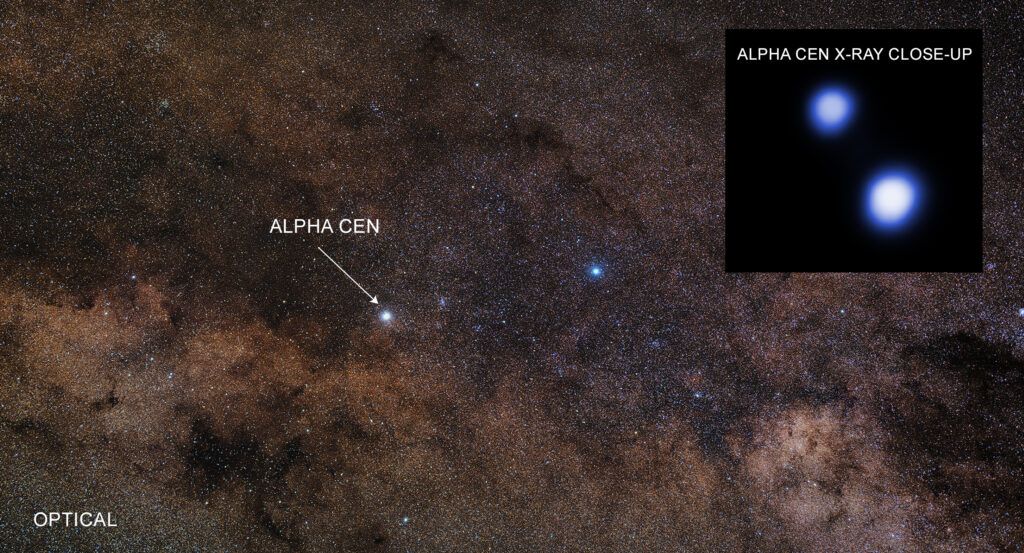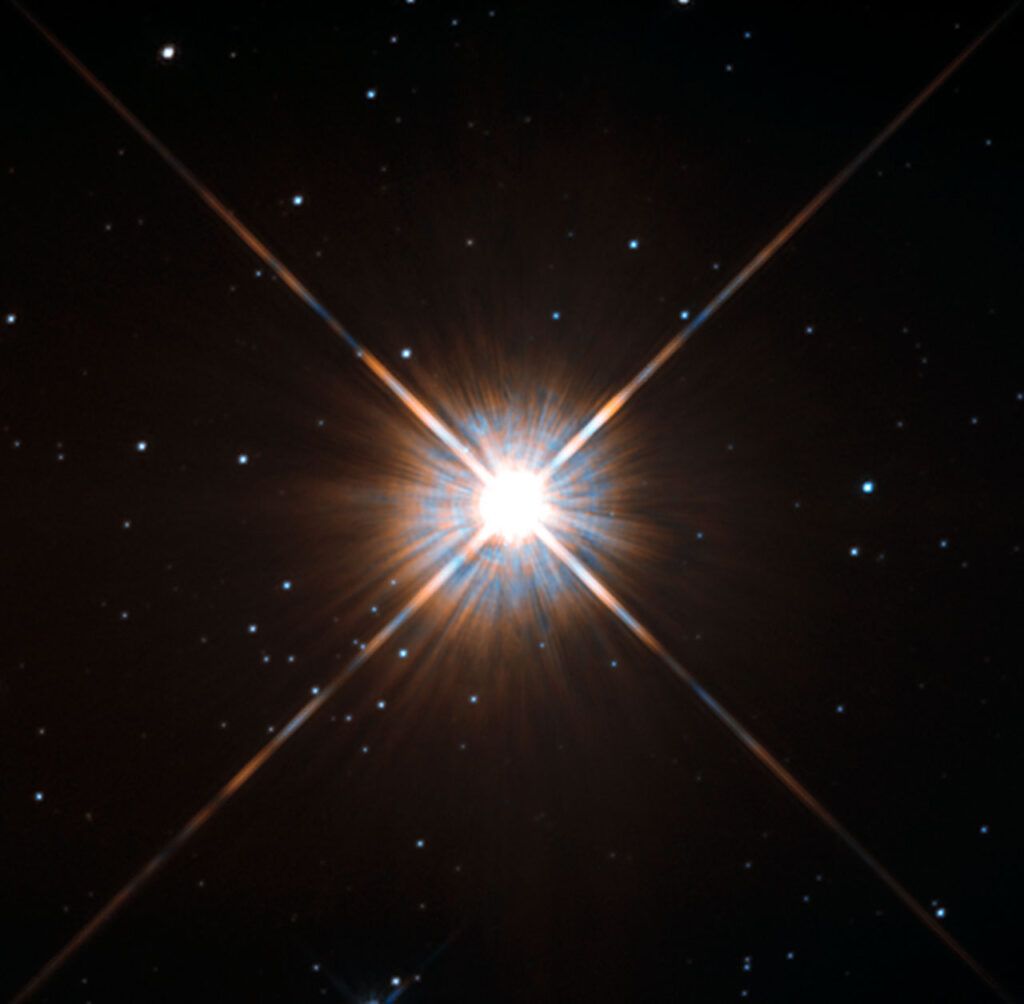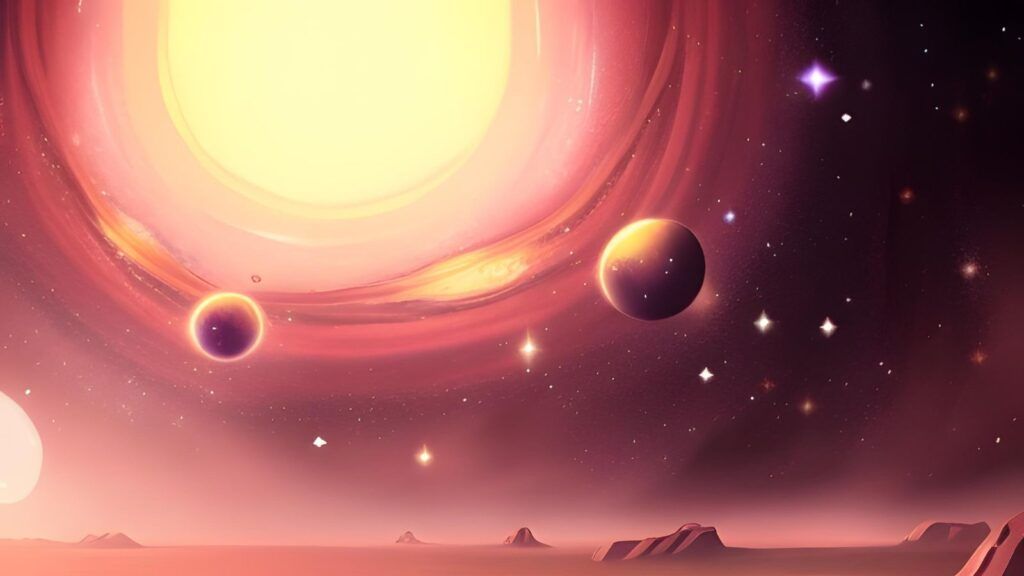Introduction: The Quest Beyond Earth
Throughout history, the mysterious and intriguing depths of the universe have continually piqued humanity’s curiosity and fascination with the possibility of extraterrestrial life existing beyond our planet. The search for habitable exoplanets in distant star systems has sparked optimism in finding another celestial haven apart from our vibrant and diverse planet Earth. Proxima Centauri B, in particular, has caught the attention and imagination of many because many scientists think that there is a possibility that aliens exist on the exoplanet Proxima Centauri B. Before We start this Article, there are some things that need to be cleared up:

Credit : NASA
- Alpha Centauri is a star system nestled within the Centaurus constellation.
- Alpha Centauri system comprises three stars: Alpha Centauri A, Toliman (Alpha Centauri B), and the smaller Proxima Centauri ( Alpha Centauri C).
- 5 Planets have been detected in the Alpha Centauri: 2 Orbiting Toliman and 3 Orbiting Proxima Centauri.
- Proxima Centauri is a red Dwarf star.
- Proxima Centauri B is a rocky exoplanet that orbits Proxima Centauri within the star’s habitable zone.
Proxima Centauri and Alpha Centauri
The Alpha Centauri star system, nestled within the Centaurus constellation, is a captivating astronomical sight. Comprising three stars, Alpha Centauri A and B, along with the smaller Proxima Centauri, it offers a fascinating glimpse into the vastness of the universe. The Proxima Centauri is the second closest star to the Earth. What is the size and mass of Proxima Centauri? It has around 12.5% of the Sun’s mass ( M ☉). Proxima Centauri has a radius of 0.154 R, that of the Sun and a mass equivalent to 0.122 M☉. The question is, how far is the second closest star to Earth besides the Sun? Proxima Centauri, our nearest cosmic neighbour, is about 4.24 light-years from Earth. Its proximity to our planet makes it a subject of great interest for astronomers and stargazers alike.
Proxima Centauri B: A Glance into the Unknown

Credit : ESA/Hubble
Among the captivating members of the Alpha Centauri family, Proxima Centauri B, often referred to as Proxima B, stands out. Now the question arises: Why the Name Proxima Centauri? What does proxima mean? In Latin, Proxima means near. The meaning of Proxima Centauri is the ‘nearest [star] of Centaurus’. This rocky exoplanet orbits Proxima Centauri within the star’s habitable zone. With a size roughly similar to Earth, Proxima B presents an enticing possibility – the presence of liquid water and, potentially, life. The exoplanet Proxima Centauri b circles an M-type star. It is 0.04856 AU away from its star, has a mass of 1.07 Earths, and orbits its star every 11.2 days. It was discovered and announced in the year 2016.
A World of Possibilities and Challenges
The distance between the Earth and the Sun, which is the closest star to Earth in miles, is around 93 Million Miles, and the Distance between Sun and the closest star to the Sun, which is Proxima Centauri, is very high. As we already know, Proxima B is a planet that goes around Proxima Centauri. Imagine how far Proxima B is from Earth. Imagine the time it will take to cover Proxima B distance from Earth using the current technology speed. The allure of Proxima B lies in its potential similarities to Earth. Its placement in the habitable zone, where conditions could allow liquid water to exist, raises exciting prospects. It depends on how hot is Proxima Centauri B.
Yeah, this is a question that many people imagine: How hot is Proxima Centauri B? Proxima B temperature is estimated to range from -40 to 104 degrees Farhenheit, depending on various factors, including its atmosphere and reflective properties. However, there’s a catch. It is tidally locked to its star, creating a permanent division between scorching daylight and frozen darkness. Yet, this challenge might be mitigated by a protective magnetic field.
Proxima B and The James Webb Space Telescope (JWST)

Credit: NASA
The James Webb Space Telescope (JWST) emerged as a technological marvel in humanity’s pursuit of understanding distant worlds. Stationed a million miles from Earth, the JWST has embarked on a cosmic mission, revealing over 4,000 exoplanets in its two-decade journey. A groundbreaking feature of the JWST is its ability to detect the vegetation red edge (VRE) biosignature, which hints at the presence of plant life on exoplanets. The James Webb Space Telescope discovered artificial lights on Proxima Centauri B. Soon, we might be able to see Proxima Centauri B James Webb images and get to know more about Proxima Centauri B artificial light.
Proxima B takes centre stage as the JWST peers into the cosmic abyss. This enigmatic exoplanet offers a unique opportunity for scrutiny. What state of matter is Proxima Centauri’s surface? Further research and exploration are required for this question soon. The JWST’s precision instruments hold the potential to unveil Proxima B’s atmospheric composition, shedding light on its habitability and the presence of life-enabling elements.
The Unanswered Questions
The study of Proxima B is not without its challenges. Direct imaging remains elusive due to the exoplanet’s distance and technological constraints. While tantalizing clues about its potential habitability emerge, the ultimate question of life’s existence on Proxima B remains unanswered. Yet, with each advancement in technology and understanding, the veil of cosmic mystery is gradually lifted likewise Sometimes, one can think, what if proxima centauri exploded? And what would happen if Proxima Centauri went supernova? If Proxima Centauri, the closest known star to our solar system, were to explode in a catastrophic event, it would have significant and far-reaching implications for the surrounding space and potentially impact nearby celestial bodies like Proxima Centauri b.
Nestled 4.24 light-years away, Proxima Centauri B captivates scientists and stokes human curiosity moreover as our closest known star after the Sun, it takes cosmic exploration to new heights. Despite proximity, this exoplanet’s direct image remains a puzzle due to distance and size challenges. Its atmospheric secrets, however, might unfold with the James Webb Space Telescope. While potentially habitable, Proxima Centauri B’s true habitability sparks ongoing debate. Water’s presence and the chance of life remain enigmatic, necessitating further investigation.
Concluding Thoughts

In the grand tapestry of the cosmos, Proxima Centauri B stands as a testament to humanity’s relentless pursuit of knowledge. As we gaze toward the stars, we’re reminded of Earth’s unique status as a cradle of life. The alluring proximity of Proxima B and the groundbreaking capabilities of the JWST encourage us to peer into the universe’s depths with renewed vigour. While the quest for answers continues, our appreciation for the delicate blue orb we call home deepens – a reminder that while the universe teems with possibilities, Earth remains an irreplaceable paradise, nurturing the diversity of life. Human habitation remains distant due to technological limits. With days lasting 11 Earth days, this world adds a touch of the extraordinary. Amid cosmic uncertainties, Proxima Centauri b shines as a symbol of mystery, inspiration, and our unwavering spirit of exploration in the vast universe.
As researchers continue to delve into its unique characteristics and environmental factors, findings from the future missions such as Artemis 3 can underline the significance of interstellar exploration. Additionally, pondering the mysteries of Proxima Centauri B evokes comparisons to enigmas closer to home, like the infamous Pan AM 914 flight missing mystery. Could solving these conundrums someday lead us to understand phenomena as mind-boggling as teleportation? The journey of uncovering answers is undeniably captivating.
What are your thoughts on this enigmatic exoplanet? Do you believe in life beyond our solar system, particularly in Proxima Centauri B? While speculative, the notion of an alien presence fuels our imaginations and sparks conversations about the vastness of the universe.
See you in the next article, Till then take care.
Can we live on Proxima Centauri B?
It's currently uncertain if we can live on Proxima Centauri b due to various factors like its distance, atmosphere, and other environmental conditions.
What is a Super Earth?
A Super Earth is an exoplanet with a larger mass and radius than Earth, but smaller than that of Uranus or Neptune.
Does Proxima Centauri B have oxygen?
The presence of oxygen on Proxima Centauri b is yet to be confirmed; it requires further exploration and study.
What is the surface of Proxima Centauri B made up of?
The exact composition of Proxima Centauri b's surface is unknown, but it's believed to be a rocky planet, potentially with a variety of minerals and elements.


Pingback: Artemis 3: Mission with First Woman and Man of Color on the Moon - Geeky Panther
Pingback: Oumuamua: Exploring the Mysterious INTERSTELLAR Wanderer - Geeky Panther